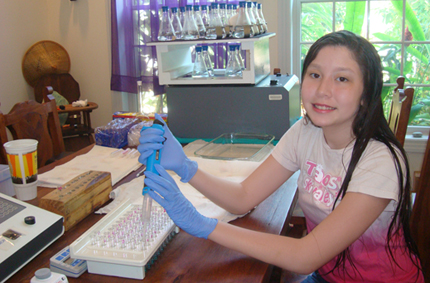Soil Science Society of America
5585 Guilford Road • Madison, WI 53711-5801 • 608-273-8080 • Fax 608-273-2021
www.soils.org
Twitter | Facebook
NEWS RELEASE
Contact: Hanna Jeske, Associate Director of Marketing and Brand Strategy, 608-268-3972, hjeske@sciencesocieties.org
Just say ‘No’ to drugs – in water
July 29, 2015 - Remember the science fair?
For some of us it was an exciting time of creative experimentation. For others it was a time of botched and badly displayed data. For 16-year-old Maria Elena Grimmett, it’s a blast. And she isn’t peddling baking soda and vinegar volcanoes.
Grimmett is tackling serious water quality issues that threaten the health of rivers, streams and groundwater. When she was just 14 years old, Grimmett was the youngest person published in the Journal of Environmental Quality. Now at 16, she has just put the final touches on her research of a plastic adsorbent that removes pharmaceutical drugs from water sources.
 Grimmett’s parents aren’t water scientists. Her interest in science is self-propelled. The journey to publication was a product of gumption, passion, and a supportive scientific community. It began with a collection of events that led her to water quality research. Grimmett remembers classroom experiments in the third grade. “My science teacher really made experiments fun,” says Grimmett, “I started to look forward to the science fair.”
Grimmett’s parents aren’t water scientists. Her interest in science is self-propelled. The journey to publication was a product of gumption, passion, and a supportive scientific community. It began with a collection of events that led her to water quality research. Grimmett remembers classroom experiments in the third grade. “My science teacher really made experiments fun,” says Grimmett, “I started to look forward to the science fair.”
In search for an interesting project for the sixth grade science fair, Grimmett noticed that the well water at her house was looking brown. After some research, she discovered she could remove the water stains using resins—tiny chains of plastic that attract contaminants, causing them to “stick” to the resins. While presenting her board at the county science fair (at which she won first place in the Environmental Science category), she noticed another student’s work on the contamination of the Everglades by pharmaceuticals. Grimmett was horrified that most water treatment filters don’t remove these drugs. Armed with purpose, she embarked on a research project to do something about it.
“It’s scary that 80% of rivers, streams, and groundwater in this country are contaminated by at least one organic contaminant,” says Grimmett. Modern water treatment tactics are good for removing common contaminants, but many pharmaceuticals and other chemicals escape treatment simply due to their extreme diversity. The drugs get into the water after excretion by humans and animals that take them medicinally. One drug in particular, sulfamethazine, is a common antibiotic fed to livestock to promote growth and to prevent diseases. “Ninety percent of it is not metabolized and ends up in water sources,” says Grimmett.
For six years, Grimmett used her summers to experiment with sulfamethazine and specific types of polymer resins, which she describes as “just small plastic beads with tiny gaps.” Water is passed through a container loaded with resins. The offending drug clings to the tiny spaces in the resins, leaving the water to flow out drug-free.
Grimmett hopes to see her research employed in the real world by water engineers. “Resins are so versatile,” she says. “I’ve only been testing for sulfamethazine, but I bet they are capable of removing more than just the one pharmaceutical.” The technique applies at any scale, from household to city water treatment.
Because of a rule restricting lab use by anyone under 16, Grimmett commandeered her family’s garage and the dining room for her experiments. Her proud parents didn’t resent the invasion of pipettes and test tubes too much, mostly because Grimmett was willing to do all the work herself.
“She was able to do it all at home due to her determination, multiple contacts with scientists and companies, and I suppose my wife and I who were willing to play ball,” says Grimmett’s father, Michael.
Grimmett has no trouble being taken seriously by her peers in the science community. “Everyone is so supportive,” she says, “Whenever I read articles and have questions for the author, they are always responsive and helpful.”
Talking to the right people, asking the right questions, and working hard on solutions has paid off. Grimmett has a lot more access to materials and expertise as a result. “It takes a village to raise a child,” says Michael Grimmett, “For Maria Elena, the ‘village’ was her global network with PhD researchers that she contacted from published articles, and forward thinking company presidents and CEOs who believed in her.”
For Grimmett, the chance to work with passionate water scientists has been one of the best parts of her work. “I love going to water conferences,” she says.
Read the details of Grimmett’s research in her article, published in the Journal of Environmental Quality.
Agronomy Journal is the flagship journal of the American Society of Agronomy. Articles convey original research in agriculture, natural resources, soil science, crop science, agroclimatology, agronomic modeling, production agriculture, and instrumentation.